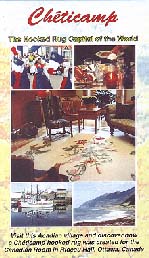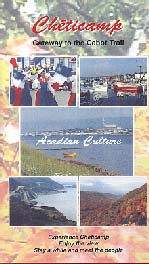|
________________
CM . . . .
Volume VII Number 13 . . . . March 2, 2001
Grades 6 and up / Ages 11 and up.
Review by Joan Payzant.
Cheticamp: The Hooked Rug Capital of the World.
This is a great video although it is a little disappointing because it is so short. The opening scenes
introduce Cheticamp, a beautiful French Acadian village in Cape Breton, Nova Scotia, with
scenes of a rowboat in a peaceful anchorage, the imposing church, heart of the village, its harbour
with fishing boats at their moorings, and a group of people on horseback riding on a long sandy
beach. French Acadian names crop up throughout the story of how hooked rugs became a major
industry in the village populated by Deveaus, Chiassons, Boudreau's, Doucets, Poiriers, and
Muises.
Through their cooperation and artistry, the unique handwork of this enterprising village is now
known in the Vatican, Buckingham Palace and the White House. Like many early settlers,
Cheticamp women hooked rag rugs out of old clothing cut into narrow strips. Gradually came the
transition to wool which they dyed themselves. Alexander Graham Bell's summer home, Beinnn
Breagh, at Baddeck was not too far from Cheticamp. Mrs. Bell and her daughter, Mrs. Fairchild,
became interested in the Cheticamp rugs and often took their visitors to see them. One of these
friends, Miss Lillian Burke of New York, made suggestions to the rug hookers to improve the
quality of their work, saying that finer wool in pastel shades would add to the beauty of the rugs.
She bought many of the rugs cheaply and sold them in New York at high prices. Unfair as this
was, she is credited with starting the big industry which Cheticamp rugs have now become.
Unfortunately a rift developed for a time amongst the rug hookers when someone heard of the
large profit Miss Burke was making. As a result, while several of the hookers remained loyal to
Miss Burke local businesses began selling the rugs right in Cheticamp.
Les Trois Pignons (a building with three gables) in Cheticamp is the home of La Societe Saint
Pierre which promotes Acadian culture. Some of the very best rugs are displayed there. Also Dr.
Elizabeth Lefort, who creates amazing tapestries, has her own gallery where her large portraits in
wool are hung.
Recently a carpet was commissioned for Rideau Hall, home of Canada's Governor General. Marie
Elwood and Marion Bradshaw of the Canadiana Fund suggested that the carpet have a central
floral cluster of the flower emblems of the ten provinces and two territories. Marie Claire
Doucette, manager of the project, chose five of the best artists to work with her on the rug.
Gilles Deveau sketched the pattern on the rug, and, after three months and innumerable stitches, it
was finished and is now in use at Rideau Hall.
Highly Recommended.
Cheticamp: Gateway to the Cabot Trail.
On a wintry Saturday afternoon with snow blowing horizontally past my window, this video,
Cheticamp: Gateway to the Cabot Trail was a joy to watch. The Village of Cheticamp, situated
on Cape Breton Island between mountains and the sea was the subject of this video made at the
height of summer. Settled in 1782 by Acadians after their expulsion from the mainland of
Nova Scotia, Cheticamp now has a population of about 4,500. The community is thriving, its
citizens working at fishing, producing crafts and attracting tourists enthusiastically experiencing
its different culture and language. To background music supplied in turn by piano, flute and
fiddles, prominent citizens comment with pride on their lives in Cheticamp. A canoe maker tells
of the serenity and beauty he finds there, a restauranteur extols the number and variety of eating
places, showing hotels, cabins, bed and breakfast homes, and campgrounds. Les Trois Pignons
(the Three Gables), cultural centre, houses the Elizabeth LeFort Gallery, which displays some of
the beautiful hooked rugs for which Cheticamp is famous. Internationally recognized artist,
Dr. LeFort, herself, tells of her craft of sketching, dyeing and hooking magnificent rugs, several of
which are shown on the video. Very early in its history, the village embraced the cooperative
movement, and now has a Caisse Populaire, grocery store, hardware store, and a rug hooking and
supply business--about which an entirely separate video has been made.
In connection with another winter festival when people dress in costumes and visit each other's
homes, a papier mache mask industry has developed, and masks, too, are on display.
Other attractions are Cheticamp's beautiful and challenging golf course, its beach and local radio
station playing music typical of the area. Nature enthusiasts can look forward to seeing many
species of birds, herons and bald eagles among them. Moose are not uncommon in the
surrounding forests, while whale watching cruises often spot pods of whales.
From Cheticamp, the renowned Cabot Trail leads tourists through beautiful Cape Breton scenery,
shown in the video at the height of its glory in autumn colors.
While the video can serve as a tourist advertisement, it also offers an intriguing example of French
culture in Acadian Cape Breton.
Highly Recommended.
Joan Payzant, a former teacher and teacher-librarian, lives in Dartmouth, NS.
To comment on this title or this review, send mail to cm@umanitoba.ca.
Copyright © the Manitoba Library Association.
Reproduction for personal use is permitted only if this copyright notice
is maintained. Any other reproduction is prohibited without
permission.
Published by
TABLE OF CONTENTS FOR THIS ISSUE - March 2, 2001.
AUTHORS |
TITLES |
MEDIA REVIEWS |
PROFILES |
BACK ISSUES |
SEARCH |
ORDER |
CMARCHIVE |
HOME
|

